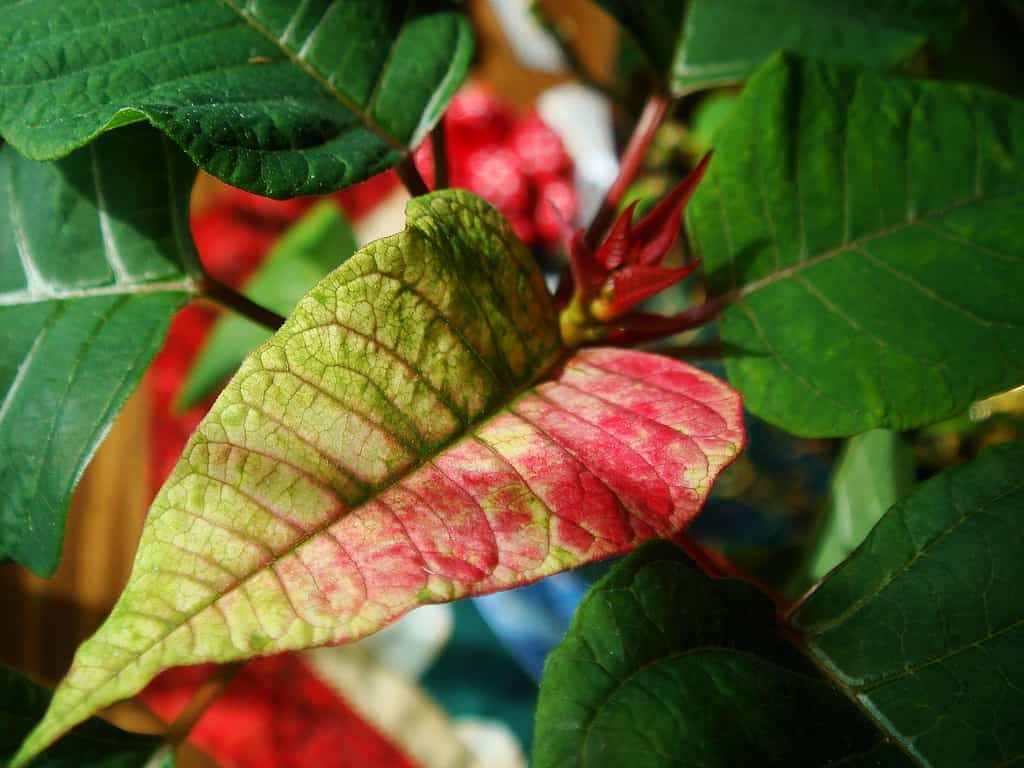A bright, cheerful plant that comes alive in time for the festive season, poinsettias (Euphorbia plurcherrima) are native to Mexico. The colored portion of the poinsettia is not actually a flower, but a plant part called a bract. The bracts change color depending on exposure to light. If you have a poinsettia from last Christmas that you want to display, you should know when it’s the best time to put your poinsettia in the dark. Otherwise, you may be disappointed when it is time to show it off for the holidays.
Why Does Your Poinsettia Need Darkness to Thrive?

Poinsettias come in various colors, including faded red, streaked red and white, yellow, white, traditional red, and more; however, they will not display these colors without the right exposure to light and darkness.
©ZoomTravels/Shutterstock.com
Without exposure to total darkness, poinsettias grown as indoor houseplants maintain their beautiful, deep green leaves. However, most people save their poinsettias in preparation for the Christmas season. Poinsettias do not rebloom automatically. Considered short day/long night plants, poinsettias require long periods of time without exposure to light. This process, called photoperiodism, signals the bracts to enter a blooming cycle that would otherwise be triggered naturally outdoors.
In their native home of Mexico and other warmer areas, people grow poinsettias commonly outside as shrubs. Incredibly, they can reach up to 10 feet tall. In Mexico, people refer to them by the nickname flor de nochebuena, or “flower of Christmas Eve,” which illustrates the average time their leaves change outside. As poinsettias began to be used as festive houseplants, this short day/long night schedule had to be artificially maintained for the same gorgeous Christmas blooms.
Best Time to Put Your Poinsettia in the Dark
By the time the days begin getting shorter in fall, around late September, you can start placing your poinsettia in the dark. Make sure you begin no later than October 1st if you want it to bloom around Thanksgiving. If you start too late, your plant might not get enough time to complete the full blooming cycle. If you miss a night, you can potentially make up for it by adding two extra days to your schedule.
Timing is key with the poinsettia. If you start on time, you should be able to stop the short day/long night routine by Thanksgiving. Display your red, white, or pink plant somewhere where it will receive at least 6 hours of sunlight.
How Long Should You Keep Your Poinsettia in the Dark?
Poinsettias require at least 14 to 16 hours of uninterrupted darkness every day to change colors by the beginning of the holiday season. However, they also need exposure to the sun. Plan to expose your plant to indirect sunlight for at least 6 hours every day to give the plant enough energy to thrive. As long as you follow this type of schedule, the bracts on the poinsettia should begin to alter.
Why Is My Poinsettia Not Changing Colors?

Even a little more exposure to light than recommended can alter how your poinsettia’s leaves change color and how much.
Make sure your plant is in complete and total darkness every night. It should not be able to reach a shred of sunlight. If you are storing it in a closet, you might want to gently drape a blanket over it. If you store it in a cardboard box, consider taping the top and cracks with duct tape to seal out the light.
Thank you for reading! Have some feedback for us? Contact the AZ Animals editorial team.








